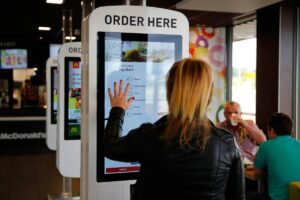
Because investing in digitization and self-service can save your business.
In 2019, large fast food chains, or Quick Service Restaurants (QSR), as they are called abroad, invested heavily in digitizing and modernizing their self-service services (Self Ordering Kiosks).
Market giants realized, even before the COVID-19 pandemic exploded around the world, that the personalization provided by artificial intelligence was the future of restaurants, as the numbers of drive-thru and delivery modalities only increased, indicating a marked change in consumer behavior.
The McDonald’s Corp group was the QSR that bet the most on digital acceleration when, just last year, it surprised the international fast food market by acquiring the technology company Dynamic Yield in a US$ 300 million operation. But the multinational knew what it was doing and invested in improving what already represented about 70% of its profit: the drive-thru service.
“Our intention is to position ourselves for long-term sustainable growth,” McDonald’s CFO Kevin Ozan said at the time. “And that’s why we’re investing in technology today. We believe that those who are not investing in technology will, at some point, be left behind and will need to catch up. And we prefer to be a little bit ahead of the curve and spend the right amount that we think will drive future growth.” With the pandemic, this decision is even more correct, since the restriction of personal contact has become a health issue and consumer behavior has changed. Thus, creating technological solutions such as smart totems, delivery apps and other digital forms of sales is essential to maintain a restaurant in the current scenario.
So, if you’re worried about your establishment’s profits falling, follow the example of leading companies in the food industry and see, below, why investing in digitalization and self-service can save your business.
Smart totems for Quick Service Restaurants (QSR)

With the purchase of Dynamic Yield, the McDonald’s chain began to overhaul its entire chain of restaurants, first in the United States, equipping them with an intelligent totem system that identifies the best menu items to be suggested according to the day or season of the year. Customers’ experience can also be customized according to their history of preferences, such as when we open a profile on Netflix or Amazon.
Smart totems work as follows: customers arrive at the ordering point and receive a personalized digital menu, adapted to order time, temperature, local events and trends. As customers make their choices, other options are recommended by generating a database of references from each customer.
The choice proved to be right with the arrival of COVID-19, as in several countries the drive-thru system of the chain has grown and now represents about 90% of McDonald’s total business, both in the United States, Canada and Australia. , according to the company’s CEO, Chris Kempczinski.
The digital acceleration of the global fast food chain is part of an orchestrated plan entitled “Experience of the Future”, which is based on three pillars:
● delivery by digital system (delivery) by own app or by
the 3rd;
● use of artificial intelligence in self-service totems (Self
Ordering Kiosks);
● redesign and digitization of stores.
Digital acceleration to face the crisis

McDonald’s is not the only fast food chain that has embraced digital transformation. KFC, Taco Bells, Wendy’s and Jack in Box are other examples of QSRs that have been investing for some time in digitalization and in technological solutions that diversify the forms of service and offer a good experience for the customer.
For Lenny Comma, CEO of Jack in Box, which has 2,200 units in the United States since 2019, it was no longer the look of the restaurant that attracted customers, but the improvements in the drive-thru and the collection system at the counter. which accelerated the service. In the new reality we live in, this issue seems even more present. Getting the food, with as little personal contact and as quickly as possible, is what people want to avoid risks of contamination.
Burger King has also recognized the strength of drive-thru and delivery modalities. According to the CEO of the famous hamburger brand in Brazil, Iuri Miranda, the drive-thru represents 50% of the chain’s sales and delivery, which grew by 800% in 2020, compared to 2019, is right behind, with 35 %.
Aware of the digital transformation movement, Burger King decided to work more on its delivery app, in addition to continuing with deliveries through the already known services – iFood, Uber Eats and Rappi –, having already conquered more than 24 million downloads of the app. The examples listed show that QSR companies anticipated what was to come, but those that did not have the same market vision urgently need to adopt a MindReset and accelerate its digitization. Creating apps for delivery and smart totems is the best strategy to face the crisis.
Changing consumer behavior and trends in Fast Food segment

Consumers, even before the epidemic, already demonstrated. sympathy for digital platforms. However, according to an Ipsos survey, at the beginning of COVID-19, it was already possible to verify changes in consumer behavior, with 16% of customers ordering food for the first time using apps and digital platforms.
According to the Infomoney website, the leader of iFood delivery apps increased its base in more than 40 thousand new restaurants from March to July 2020 in the app delivery market, that is, as a whole, demand increased 250% in the period, according to with Food Consulting. The average ticket of the apps also went up, because staying at home for longer, people started ordering meals for the whole family.
Therefore, behavior and consumption trends were accelerated and became a reality due to the imposition of the “new normal”. Even with the reopening of restaurants in several countries, including Brazil, which adopts different protocols for each state or municipality, hygiene care had to be redoubled and the number of tables had to be reduced to meet minimum distance requirements between customers. .
Many establishments preferred to adopt the take-away system to guarantee the recipe and not close their doors and this pleased the consumer, who has preferred to eat their meal at home. The same is true of the United States and some parts of Europe, which have loosened social distancing rules and allowed commerce to reopen.
Restaurants, fast foods, bars and cafes are testing new formats that eliminate seating areas and encourage consumption in open spaces. In the Philippines, a chain specializing in hamburgers and burritos has launched a service that allows parking in exclusive places so they can eat in the car. In Spain, the CDR Goiko restaurant offers a reduced menu of special items on the take-away system, and in China, many QSRs are opening stalls on the street.
Food industry experts believe the changes are here to stay. To David Gibbs, CEO of Yum! Brands – owner of Taco Bell, Pizza Hut and KFC – the first three months of the pandemic were enough to accelerate many business trends that would take years to happen, such as digital orders and payments. “It’s a mindset shift,” he said in a webinar hosted by BTG Pactual. For CEO Gibbs automation has a bigger role to play in business to reduce physical contact. For him, curbside pickup, that is, take-away and drive-thru systems are advantageous for customers, as they reduce time and cost. “So this is a change that is here to stay after the pandemic,”
he concluded.
What is the future of Quick Service Restaurants (QSRs)?

With all these demonstrations that new times have arrived, it is possible to predict that the future of QSRs will be technological. Either restaurants adapt to the new reality and accelerate their digitization or they will not survive for long. And this is not just because of the pandemic, but because of consumer behavior, which will require novelties, such as digital payment and other facilities.
A Tencent Research Institute survey of more than 1,600 Chinese companies revealed consensus that digitization is an important survival strategy and that COVID-19 has become an accelerator of digital transformation. Most companies surveyed aim to increase their digitization investments by between 10% and 30%, using technologies such as big data, IoT (Internet of Things), cloud storage and 5G.
In Brazil, digital acceleration is also a reality and with the launch of PIX, the Central Bank’s 24-hour on-time payment system, scheduled to arrive by November, this transformation should take on an even faster pace. On this treadmill, smart totems that collect and analyze customer data, delivering personalized options, will spread across various business segments. Digital payment, without the use of a physical card, through a QR Code or a social network should also arrive quickly and take off in the country that has a large consumer market and is very receptive to the use of social networks and digital platforms. Proof of this is the downloads of delivery apps that grew 700% during the quarantine in São Paulo.
That is, in the very near future, all large fast food chains will have self-service totems and delivery apps to offer their customers. With this, the consumer will have access to easy-to-operate tools, avoiding queues and physical contact, which will only take place when the product is picked up at the counter or when it is received at home.
But for the experience to be the best possible, it is necessary to ensure the consumer’s power of choice. Therefore, technology cannot be only within the reach of market giants. Small restaurants and family businesses also need to adapt to meet that most demanding customer in terms of gastronomy.
In Brazil, most restaurants have this profile, but they face some difficulties in implementing new technologies, such as lack of financial resources and technical lack of knowledge to evaluate the best solution for their business, among other obstacles.
How to implement digital acceleration in your business

As you have seen, digital acceleration is permanent and absolutely necessary for the survival of companies during and after the pandemic. Thus, it is necessary, before any change, to adopt a MindReset and abandon old concepts, reprogram goals and establish new objectives.
Then, with the support of a consultancy such as Business Reset, it will be possible to assess the best solutions for the company, taking into account a series of factors, including available resources and the business model.
The self-service totem, for example, is an excellent solution for restaurants that work with fast foods, and this can be the perfect solution for your company. It should be noted that for these and all other self-service models, an exclusive delivery app may be essential. In some cases, the digitization will have to be complete, aligning several technological tools.
It is important that you keep in mind that your final customer will validate your choice. It is he who will decide if the solution you have adopted was the most suitable for your restaurant. Therefore, before starting the project, it is necessary to carry out a survey with the consumers of your establishment in order to understand their habits and tastes, in addition to investigating and knowing the competition. Also try to find out about industry statistics. A survey carried out in June 2020 by the Associação de Bars e Restaurantes de São Paulo, for example, revealed that 80% of restaurants that work in delivery are dissatisfied with the service of already known applications. This is data that says a lot about the market and may indicate the need to invest in their own app, as many establishments are already doing. Regardless of choice, know that the future of fast foods and other business models depends on digital acceleration. It is a matter of survival and not a choice for the modern or the traditional.
Start today to change your MindReset and invest in technology for your restaurant. Contact Business Reset and request a free evaluation.

